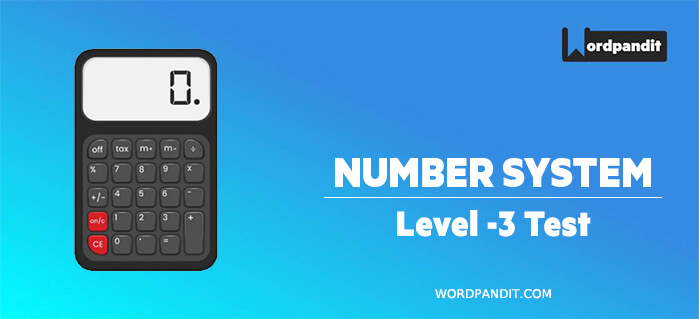- This is an assessment test.
- To draw maximum benefit, study the concepts for the topic concerned.
- Kindly take the tests in this series with a pre-defined schedule.
Number System: Level 3 Test -6
Congratulations - you have completed Number System: Level 3 Test -6.You scored %%SCORE%% out of %%TOTAL%%.You correct answer percentage: %%PERCENTAGE%% .Your performance has been rated as %%RATING%%
Your answers are highlighted below.
Question 1 |
Out of two-thirds of the total number of basketball matches, a team has won 17 matches and lost 3 of them. What is the maximum number of matches that the team can lose and still win more than three fourths of the total number of matches, if it is true that no match can end in a tie?
4 | |
6 | |
5 | |
3 |
Question 1 Explanation:
Total number of matches won plus lost = 2/3(total number of matches)
That is 17+3 = 2/3 (total number of matches)
This means total number of matches = 30
Now we know they win more than 3/4th of the total number of matches that is they win more than 22.5 matches.
Obviously you cannot win half a match, so we chose the next integral value, that is 23.
They need 6 more to win from their remaining games and since they have played 20 games, from the remaining 10 games,
they can lose a maximum of 4 games.
That is 17+3 = 2/3 (total number of matches)
This means total number of matches = 30
Now we know they win more than 3/4th of the total number of matches that is they win more than 22.5 matches.
Obviously you cannot win half a match, so we chose the next integral value, that is 23.
They need 6 more to win from their remaining games and since they have played 20 games, from the remaining 10 games,
they can lose a maximum of 4 games.
Question 2 |
A, B, C, D, ..., X, Y, Z are the players who participated in a tournament. Everyone played with every other player exactly once. A win in the match fetch 2 points, a draw fetch 1 point and a loss fetch 0 point. None of the matches ended in a draw. No two players scored the same score. At the end of the tournament, by ranking list is published which is in accordance with the alphabetical order. Then
M wins over N | |
N wins over M | |
M does not play with N | |
None of these |
Question 2 Explanation:
It can be seen that each of the 26 players played 25 matches.
Since none of the matches ended in a draw, the scores for each of the players have to be even (since a win gives 2 points).
So the highest score possible for a player would be 50 and the lowest would be 0.
Since all 26 of them had different scores varying between 0 and 50, the scores should indeed be all the even number between 0 and 50.
And since the ranks obtained by players are in alphabetical order,
it can be concluded that A scored 50, B scored 48, C scored 46 and so on and Z scored 0.
Now the only way A can score 50 is, if he wins all his matches, i.e. he defeats all other players. Now B has scored 48.
So he has lost only one of his matches, which incidentally is against A. He must have defeated all other players.
Similarly, C has scored 46 matches. So he must have lost two matches, (i.e. to A and B) and defeated all other players.
So we conclude that a player whose name appears alphabetically higher up in the order has defeated all the players whose name appears alphabetically lower down.
Hence, M should win over N.
Since none of the matches ended in a draw, the scores for each of the players have to be even (since a win gives 2 points).
So the highest score possible for a player would be 50 and the lowest would be 0.
Since all 26 of them had different scores varying between 0 and 50, the scores should indeed be all the even number between 0 and 50.
And since the ranks obtained by players are in alphabetical order,
it can be concluded that A scored 50, B scored 48, C scored 46 and so on and Z scored 0.
Now the only way A can score 50 is, if he wins all his matches, i.e. he defeats all other players. Now B has scored 48.
So he has lost only one of his matches, which incidentally is against A. He must have defeated all other players.
Similarly, C has scored 46 matches. So he must have lost two matches, (i.e. to A and B) and defeated all other players.
So we conclude that a player whose name appears alphabetically higher up in the order has defeated all the players whose name appears alphabetically lower down.
Hence, M should win over N.
Question 3 |
A shop stores x kg of wheat. The first customer buys half x amount plus half a kg of wheat. Then second customer buys half the remaining amount.Then the third customer also buys half the remaining amount plus half a kg of wheat. Thereafter, no wheat is left in the shop. Which of the following best describes the value of x?
2 ≤ x ≤ 6 | |
5 ≤ x ≤ 8 | |
9 ≤ x ≤ 12 | |
11≤ x ≤ 14 |
Question 3 Explanation:
Amount of wheat bought by the first customer (x/2+1/2 ) kgs
Amount of wheat remaining = x – (x/2+1/2) = x-1/2 kgs
Amount of wheat bought by the second customer = 1/2(x-1/2)
Amount of wheat remaining = (x-1/2) - (x-1/4) =x-3/4
Amount of wheat bought by the third customer = ½ (x-3/4) +1/2=x+1/8 kgs
As per the information given in the question
Because there is no wheat left after the third customer has bought the wheat.
Therefore, the value of ‘x’ = 7 kgs.
Amount of wheat remaining = x – (x/2+1/2) = x-1/2 kgs
Amount of wheat bought by the second customer = 1/2(x-1/2)
Amount of wheat remaining = (x-1/2) - (x-1/4) =x-3/4
Amount of wheat bought by the third customer = ½ (x-3/4) +1/2=x+1/8 kgs
As per the information given in the question
Because there is no wheat left after the third customer has bought the wheat.
Therefore, the value of ‘x’ = 7 kgs.
Question 4 |
Suppose you have a currency, named Won, in three denominations: 1 Won, 10 Wons and 50 Wons. In how many ways can you pay a bill of 107 Wons?
17 | |
18 | |
16 | |
15 |
Question 4 Explanation:
Let the number of currency 1 Won, 10 Wons and 50 Wons be x, y and z respectively.
⇒ x + 10y + 50z = 107 Now the possible values of z could be 0, 1 and 2.
For z = 0: x + 10y = 107
Number of integral pairs of values of x and y that satisfy the equation x + 10y = 107 will be 11.
These values of x and y in that order are (7, 10); (17, 9); (27, 8)… (107, 0).
For z = 1: x + 10y = 57 Number of integral pairs of values of x and y that satisfy the equation x + 10y = 57 will be 6. These values of x and y in that order are (7, 5); (17, 4); (27,3); (37, 2); (47, 1) and (57, 0).
For z = 2: x + 10y = 7
There is only one integer value of x and y that satisfies the equation x + 10y = 7 in that order is (7, 0).
Therefore total number of ways in which you can pay a bill of 107 Wons = 11 + 6 + 1 = 18
⇒ x + 10y + 50z = 107 Now the possible values of z could be 0, 1 and 2.
For z = 0: x + 10y = 107
Number of integral pairs of values of x and y that satisfy the equation x + 10y = 107 will be 11.
These values of x and y in that order are (7, 10); (17, 9); (27, 8)… (107, 0).
For z = 1: x + 10y = 57 Number of integral pairs of values of x and y that satisfy the equation x + 10y = 57 will be 6. These values of x and y in that order are (7, 5); (17, 4); (27,3); (37, 2); (47, 1) and (57, 0).
For z = 2: x + 10y = 7
There is only one integer value of x and y that satisfies the equation x + 10y = 7 in that order is (7, 0).
Therefore total number of ways in which you can pay a bill of 107 Wons = 11 + 6 + 1 = 18
Question 5 |
A confused bank teller transposed the rupees and paise when he cashed a cheque for Sheila. giving her rupees instead of paise and paise instead of rupees. After buying a toffee for 50 paise, Sheila noticed that she was left with exactly three times as much as the amount on the cheque. Which of the following is a valid statement about the cheque amount?
Over Rupees 13 but less than Rupees 14 | |
Over Rupees 4 but less than Rupees 5 | |
Over Rupees 22 but less than Rupees 23 | |
Over Rupees 18 but less than Rupees 19 |
Question 5 Explanation:
Suppose the cheque for Sheila is of Rs. X and Y paise.
As per the question: 3 × (100X + Y) = (100Y + X) – 50 ⇒ 299X = 97Y – 50 Y= 299X+ 50/97
Now the value of Y should be an integer.
By simply checking the options, we can identify option (d) as the answer.
As per the question: 3 × (100X + Y) = (100Y + X) – 50 ⇒ 299X = 97Y – 50 Y= 299X+ 50/97
Now the value of Y should be an integer.
By simply checking the options, we can identify option (d) as the answer.
Once you are finished, click the button below. Any items you have not completed will be marked incorrect.
There are 5 questions to complete.
List |






